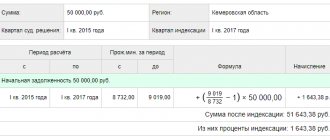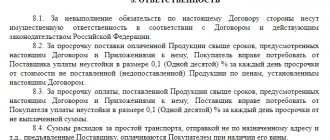What is a penalty for alimony?
From a legal point of view, a penalty is a sum of money paid by the debtor to the creditor in the event of non-fulfillment or improper fulfillment of obligations. This wording is specified in Art. 330 Civil Code of the Russian Federation.
Collection of the penalty is carried out voluntarily, when the debtor does not deny his guilt. In this case, he can independently transfer the money to the other party in order to avoid litigation.
To avoid troubles, it is recommended to keep bank receipts so that if problems arise, you will be able to confirm the voluntary fulfillment of obligations in court. If payment is made in cash, it is necessary to obtain a receipt from the claimant.
There is another way to claim penalties - through the court. The initiator is the party receiving the service, in the case of alimony - money. When it comes to collecting penalties for child support payments, the plaintiffs are usually women, since they are the ones who remain with minors.
Grounds and conditions for collecting penalties
The main condition for collecting a penalty is that the alimony payment is late by at least 1 day. The deadlines for paying money for the maintenance of minors are indicated in writs of execution (IL), alimony agreements or court orders.
For example, payments should have been received on January 12, 2018, but the claimant received them on January 15, 2018; for the specified period, he has the right to claim a penalty.
Other recovery conditions:
- Established child support obligations. The debtor must pay alimony by agreement, IL or court order. If the recipient has not previously gone to court or has not drawn up an agreement with the payer at the notary, it is not a penalty that is collected, but alimony for the past period - a maximum of 3 years preceding the date of filing the claim with the court.
- Existence of debt. It begins to form on the day following the day when the payment was supposed to arrive.
Important! The law allows for alimony agreements to be drawn up between spouses or former spouses. They must think through its content independently, focusing on the provisions of Chapter. 16 IC RF. When the document does not indicate that a penalty will be collected if there is a delay, it is problematic to obtain it even in court.
Specific terms and amounts of alimony debt for going to court are not established by law. A claim can be filed even after a week, but the amount of payments will be minimal - no more than 500 rubles. depending on the amount of alimony.
It is recommended to file a claim after 5-6 months from the date of non-payment: in this case, it will be possible to withhold a large amount from the payer. In some cases, it exceeds the amount of the principal debt.
How to file a claim correctly
In order for a claim for alimony to be accepted for consideration, it must be drafted correctly. The application is written in accordance with the rules established by Art. 131 and art. 132 Code of Civil Procedure of the Russian Federation. It must include the following information:
- In the address part: information about the judicial authority to which the application is submitted, full name, address and contacts of the plaintiff and defendant.
- Title of the claim: “On the collection of a penalty from (full name of the debtor) for late alimony payments.”
- In the main part:
- details of the document on the basis of which alimony is collected;
- who should pay the funds and in whose favor, in what way (in shares, in a fixed amount, and so on);
- the date from which the arrears began, determine the entire period of debt accumulation;
- justify the amount of the penalty using a table reflecting the monthly accumulation of penalties;
- The claims indicate a request to recover from the defaulter the entire amount of the overdue amount, as well as to exempt the plaintiff from paying the fee for filing a claim.
- At the end of the application, a list of documents attached to the claim is indicated (all documents are submitted in 2 copies).
You can file a claim in court by mail. In this case, you need to send a registered letter with notification to find out when the office will receive the documents. If possible, it is better to personally take the claim and documents to the court office. In this case, you should ask the employee of the institution to put a stamp on acceptance of the application on the applicant’s copy.
In some regions, it is possible to file an application to the court online, using the State Automated System (SAS) “Justice”. In this case, the claim and attached documents are sent to the government agency in the form of scanned copies. To use the electronic service, you need to have a verified account on the State Services portal.
Amount of penalty for alimony
In 2021, Federal Law No. 224 came into force, according to which, by order of the President of the Russian Federation, the amount of the penalty was reduced from 0.5 to 0.1% of the debt amount for each day of delay.
These changes are beneficial to debtors, but not beneficial to recipients. The reason for the publication of the law was the accrual of huge alimony debts, which cannot be collected due to the expiration of the statute of limitations, the payers lack of official work or property ownership.
Thanks to the Federal Law, those obligated for alimony have the opportunity to be released from the obligation to pay the penalty in whole or in part, if it is proven that the debt was not caused by their fault and they have valid reasons that do not allow them to pay off the debt.
Reducing the amount of the penalty
There are two ways to apply for a reduction in the amount of the penalty or exemption from its payment - by filing an objection to the claim or a counterclaim. This is possible if there are grounds specified in Art. 114 RF IC:
- lack of guilt;
- valid reasons for non-payment.
Good reasons should be understood as factors for which payments were not made regardless of the payer’s wishes: conscription for military service, long-term treatment for a serious illness, etc.
Collection of alimony debt after 18 years: procedure and deadlines
How to reduce the amount of alimony penalties?
We calculate the amount of penalties for late payment (by law or agreement)
Since the claim must be accompanied by a calculation of the penalty, it is recommended that you do it yourself. It fits into the text of the appeal or can be drawn up as a separate document, which is attached to the claim.
The calculation is carried out for each month separately, then all values are summed up. These calculations must appear in the filed claim or in an addendum thereto.
The penalty is calculated according to the law using the formula H = C × D × 0.5/100, where:
- N – size of the penalty;
- C – amount of alimony debt for the billing month;
- D – number of overdue days.
If the amount of the penalty was determined by agreement between the spouses, then the formula looks like this: H = S × D × P, where:
- N – size of the penalty;
- C – amount of alimony debt for the billing month;
- D – number of overdue days;
- P – percentage of the amount of debt, which is determined by the agreement.
In some cases, payers may partially transfer money towards alimony. Since the debt to the recipient still remains, he has the right to demand a penalty. In this case, the value of the debt changes, which is defined as the difference between the established amount of alimony and the partial contribution.
Let's find out who should calculate the penalty by reading a special article prepared by the editors of our website.
Calculation of penalties for alimony
If alimony is ordered by the court and the writ of execution is submitted to the FSSP, the claimant must apply to the bailiff for a ruling on the calculation of the debt.
The calculation itself is carried out as follows:
- The number of days of delay is determined.
- The payer's earnings for the above period are established. When this is not possible, the calculation is based on the average earnings in the country. The absence of an official place of work is not grounds for exemption from payment.
- The amount of the principal debt is summed up and then multiplied by 0.1%. The result obtained reflects the amount of the penalty for 1 day of delay.
- The amount of the penalty for 1 day is multiplied by the number of days of non-payment.
When collecting a penalty for late alimony in a fixed amount of money, the calculation is carried out taking into account the indexation performed.
Important! In addition to the penalty and the principal debt, the defaulter is charged an enforcement fee of 7% for each debt (Article 112 of Federal Law No. 229).
Alimony penalty calculator
Calculator from Dogovor-Yurist.Ru
An example of calculating alimony penalties as a share of salary
Yudin S.V. is obliged to pay alimony for one child according to the writ of execution, the amount of payments is 25% of the salary. The average salary of a payer is 30,000 rubles. There was a delay in alimony obligations of 953 days.
30,000 x 25% = 7,500 rub. payable monthly.
7500 x 32 (months) = 240,000 rubles. – the total amount of alimony debt for the period of delay.
240,000 x 0.1% = 240 rubles. – penalty for 1 day of non-payment.
240 x 953 = 228,720 rub. – penalty for the entire period.
228,720 + 240,000 = 468,720 rubles. – the total amount of debt.
An example of calculating alimony penalties in a fixed amount
Musov O.P. was ordered to pay alimony for the maintenance of two children, the amount is 17,000 rubles. monthly. He was 91 days overdue on his payment.
17,000 x 3 (months of non-payment) = 51,000 rubles. – total amount of debt.
51,000 x 0.1% = 51 rub. – penalties for 1 day of non-payment.
51 x 91 = 4,641 rub. – the total amount of the penalty.
51,000 + 4,641 = 55,641 rubles. – the total amount of debt.
For comparison, consider an example where the calculation is carried out at the old rate - 0.5% of the debt amount. The conditions are similar.
51,000 x 0.5% = 255 rubles. – penalty for delay of one day.
255 x 91 = 23,205 rub. – the amount of the penalty.
23,205 + 51,000 = 74,205 rubles. – total payable (principal debt + penalty).
As can be seen from the example, reducing the amount of the penalty at the legislative level allowed debtors to avoid more significant penalties.
We determine the amount of the penalty online
For clarity, below are examples from legal practice.
Example 1
The alimony debt as of September 1, 2021 was formed over the previous three months and amounted to:
- For June – 12 tr;
- For July - 14 tr;
- For August – 14 tr.
The agreement was not drawn up, so the calculation was carried out according to the law according to the above formula. The penalty for alimony is calculated using the formula N = C × D × 0.5/100.
Thus, the amount of the penalty is:
- On July 1 - 12 tr. × 30 × 0.5/100 = 1.8 tr.;
- On August 1 – (14+12) tr.×31×0.5/100=4.03 tr.;
- On September 1 - (14+14+12) tr.x31x0.5/100=6.2 tr.
The total penalty for the three summer months amounted to 12.03 tr. The total amount of the claim was 14+14+12+12.03=52.03 tr.
Example 2
In another calculation method, you need to make an adjustment in advance for the number of days that alimony was not paid for a specific month as of September 1:
- For June – 30+31+31=92 days;
- For July – 31+31=62 days;
- For August – 31 days.
Thus, the amount of the penalty is:
- On July 1 - 12 tr. × 92 × 0.5/100 = 5.52 tr.;
- On August 1 - 14 tr. × 61 × 0.5/100 = 4.34 tr.;
- On September 1 - 14 tr. × 31 × 0.5/100 = 2.17 tr.
The total value of the penalty is 5.52 + 4.34 + 2.17 = 12.03 tr. As in the previous calculation method, the total amount of the claim was 14 + 14 + 12 + 12.03 = 52.03 tr.
The order of collection of penalties for alimony
The legislation contains the concept of “priority of payments”, meaning the degree of importance of various contributions of citizens withheld in the presence of several obligations.
Alimony is a priority payment. The same applies to the penalty, but it will be withheld secondarily after the main alimony debt has been claimed. Here you need to take into account Art. 99 Federal Law No. 229, where the total amount of deductions under the executive document cannot exceed 50%.
For example, if alimony is 25%, the remaining 25% may be withheld to pay off the debt. When collecting payments for three children in the amount of 50%, it is allowed to increase the established threshold to 70%, and then 50% will be collected to cover the principal debt, and the remaining 20% will be a penalty.
Alimony and penalties for it, compensation for harm to health, compensation for moral damage are in first place in order of priority. These are followed by other payments:
- collection of royalties, severance pay;
- taxes and other government fees;
- claims of creditors and other payments.
The order of priority should be followed by the organization at the place of employment of payers, as well as by banks, if citizens’ earnings pass through them. If there are insufficient funds in the account, alimony is transferred first, and then the remaining contributions.
The corresponding note on the mandatory transfer of money for the maintenance of minors is placed in the payment order submitted by accountants to financial institutions.
Grounds for collecting penalties under the law
The grounds and procedure for collecting penalties for alimony are prescribed in Article 115 of the RF IC. You can collect a penalty from the first day of late payments. However, doing this is not entirely advisable.
General information about the features of alimony penalties is described in a special material. Recommended reading.
The fact is that penalties can be collected only if the debtor’s guilt for late payments is proven, and it will be quite difficult to prove guilt for a small delay in payment. In addition, since the amount of the penalty depends on the duration of the debt, it will simply be unprofitable to initiate legal proceedings due to several days of non-payment.
Practicing lawyers in the field of family law recommend filing a lawsuit to collect a penalty no earlier than after 5 months of late payments.
Alimony can be paid voluntarily - on the basis of a notarized agreement, or compulsorily - on the basis of a writ of execution. In both cases, you will need to present these documents when going to court. But if the agreement between the spouses was concluded verbally or not notarized, then it will be quite difficult to obtain alimony penalties, even if there are all the grounds.
Collection of penalties for alimony
The step-by-step collection procedure looks like this:
- The claimant submits an application for execution of a decree on debt settlement to the bailiff who opened enforcement proceedings (IP) initially after presentation of the IL.
- The bailiff issues the order within 10 calendar days. You must receive it in person, or when applying, indicate delivery by Russian Post in your application.
- A statement of claim is drawn up, then, with the accompanying documentation, it is submitted to the magistrate’s court at the place of residence of the defendant or plaintiff.
- The judge initiates proceedings within 5 days, and the parties are notified of the date of the first court hearing. The defendant is sent a notice along with a copy of the claim.
- The case is being prepared for trial.
- A hearing is being held. As a result, a decision is made on partial or full satisfaction of the claims or refusal to satisfy them.
Important! If the court decision does not suit the plaintiff or defendant, before it enters into legal force, they can appeal it to the appellate instance. After this, an appeal is made by filing a cassation appeal.
Jurisdiction
According to the Resolution of the Plenum of the Armed Forces of the Russian Federation dated December 26, 207, a claim for the recovery of alimony penalties is filed in the magistrate’s court at the registered address of the defendant or plaintiff.
The specific judicial body is determined by the plaintiff.
Application for calculation of alimony debt
The application form can be downloaded on the website of the regional division of the FSSP or on our website.
To fill out you will need the following information:
- name of the FSSP;
- Full name, address and telephone number of the claimant;
- date and number of the IL issued earlier;
- Full name of the bailiff;
- Full name, place of registration of the debtor and the child for whom alimony was collected;
- the date of the last payments made to those liable for alimony;
- the specific period for which it is necessary to determine the amount of debt;
- request to determine the amount of debt;
- date of compilation and signature;
- list of attached documentation.
Sample statement of claim:
After submitting the application, the claimant is given a notice indicating the deadline for the resolution to be ready. Subsequently, it is sent to the debtor at the initiative of the bailiff.
Contents of the statement of claim
Samples of statements of claim are not established for citizens, but when filing, it is important to comply with the content requirements.
The claim includes the following information:
- name of the judicial authority;
- Full name, registration addresses of the plaintiff and defendant;
- information from the IL issued earlier;
- period of non-payment of alimony;
- on what basis were payments collected for the child (court order, IL, agreement, etc.);
- the amount of debt on alimony payments;
- the amount of the penalty;
- information about the child;
- number of the resolution on debt settlement;
- a list of attached documents;
- demand for collection of debt and penalties for alimony;
- number and signature.
Sample and form of claim
In the requirements section, the payment of the enforcement fee is not indicated - its collection is within the competence of the bailiffs.
List of attached documents
When filing a claim in court, you will need documentation confirming the validity of the claims:
- resolution on debt settlement;
- the plaintiff's passport and the child's birth certificate. If there are several children, certificates of all are provided;
- IL, order or agreement on the basis of which alimony is collected.
Upon acceptance, copies are made of documents and the originals are given to the owner.
State duty amount
In accordance with current legislation, plaintiffs wishing to collect alimony or penalties for it are exempt from paying state duty. Subsequently, it is recovered from the defendants. For one child you will have to pay 150 rubles.
Arbitrage practice
In cases of recovery of penalties, judicial practice is ambiguous. In most cases, the courts accept the position of the plaintiffs, but when drawing up a decision, they are guided not only by the interests of the children, but also by the justification of the claims, as well as the financial situation of the parties.
During the preparation of the case for proceedings, the defendant may file an objection with a request to reduce the amount of the penalty or to exempt it from payment completely. This is possible if there are legal grounds. Partial exemption is also permitted.
Liability for non-payment
If the alimony payer does not make payments at the right time, more serious penalties may be applied to him.
In some situations, you can even open a criminal case. In addition, the child's mother can sue to deprive her of parental rights. Be sure to remind the debtor of this if he does not fulfill his obligations.
Here you need to understand that sometimes the court may consider the reason for non-payment to be valid and mitigate its punishment. Valid reasons include:
- serious disease;
- dismissal from work;
- receiving disability;
- the appearance of other children in the debtor’s family.
Question My ex-husband has a serious alimony debt. I recently filed a lawsuit to calculate the debt and interest on it for the previous 3 months. My requirements were fully satisfied. Now I want to re-file the lawsuit to recover a penalty from my husband for a different period of time. Is it possible to do this? Answer Yes, you can re-file the claim for settlement for a different period of time. This can be done by filing a claim in the magistrate's court.
Limitation period for collecting alimony penalties
The penalty is collected at any time, even if at the time of filing the claim the child for whom alimony was paid was 18 years old. The general statute of limitations under the Civil Code of the Russian Federation is 3 years, but this does not apply to the collection of payments for children and penalties for them.
What it looks like in practice:
According to the IL, the man was obliged to transfer money for the maintenance of one child in June 2012. The amount of alimony is 10,000 rubles. the last payment was received in January 2015, and in August 2021 the payer’s son turned 18 years old, which is the basis for exemption from child support obligations.
In February 2021, the woman went to court to recover penalties for 36 months.
The principal debt is accrued for the period from February 2015 to July and part of August 2021, and the penalty is calculated from the moment of the last payment until the date of execution of the settlement order. Number of days – 1096. How everything is calculated:
10,000 x 16 (months of non-payment) = 160,000 rubles. - main debt.
160,000 x 0.1% = 160 rubles. – penalty for the day of non-payment.
160 x 1096 = 175,360 rub. – penalty in general.
175,360 + 160,000 = 335,360 rub. – total payment.
Learn more about the statute of limitations for collecting alimony penalties.
Case resolution practice
The claim is filed against the alimony payer, in which demands are made to pay:
- Debt in material payments for a child in the amount of 265 tr.
- Penalty for late payments – 441 tr.
The latter is calculated according to the law, taking into account half a percent for each day of delay. The magistrate decided to impose a penalty in the amount of 5 tr. The motivation is the defendant’s low salary, which does not allow him to pay such amounts .
The plaintiff is dissatisfied with this decision and files an appeal with the city court, which leaves her original decision unchanged. The regional court noted that the delay in payments was caused not by the defendant’s intentional actions, but by the dishonest actions of his employer. Additionally, it was established that at the time of filing the claim, the defendant’s child had reached the age of majority. The case was returned to the magistrate for retrial.
Read more about judicial practice on the collection of penalties here.
In another case, the court considered the claim of the child’s guardian, his grandmother, against the baby’s mother. The requirement for the defendant is to pay a debt of 42 thousand rubles. and a penalty of 15.5 tr. During the meeting, it was established that the penalty was calculated incorrectly, it was 2 tr. should be less. The rest of the claim was satisfied in full, including the adjusted amount of the penalty.
Lawyer's answers to questions about collecting penalties
How is the penalty collected if the debt is paid gradually?
If the bailiff's order has already been drawn up, the penalty is collected in the amount determined from the debt specified in it, even if after filing the claim the debtor began to pay it.
When a new debt is formed, another resolution is drawn up, and it is collected under a separate IL.
If the alimony obligee pays part of the assigned alimony, he also develops a debt for the actually unpaid part. For example, when depositing 5,000 rubles. from the established amount of 12,000 rubles. the penalty will be charged at 7,000 rubles.
Is it possible to collect a penalty if the alimony debt is fully repaid?
If the debt is repaid before the creditor goes to court, there is an opportunity to claim a penalty. To do this, it is enough to contact the bailiff for a ruling, then file a statement of claim. Voluntary repayment of a debt does not exempt you from paying a penalty.
Is it possible to claim a penalty if the child is already 18 years old?
Once a child reaches the age of majority, a fine can be collected at any time. Statutes of limitation do not apply.
Is a penalty collected if the debtor does not work?
Lack of employment does not exempt from alimony obligations, and penalties are collected according to the algorithm presented above. However, in this case, the average earnings in the country are used for calculation, since it is not possible to determine the payer’s income.
Is a penalty collected if the writ of execution was withdrawn or not presented?
Judicial practice on this issue is ambiguous. According to the Definition of the Armed Forces of the Russian Federation, if the claimant does not present the IL within 3 years or revokes the document, the debt obligations for the debtor are canceled. Motive - to collect a penalty, it is necessary to initiate an individual entrepreneur, and a court decision alone is not enough.
Can the penalty exceed the amount of the principal debt?
Yes maybe. It all depends on the amount of alimony and the duration of the delay. Only deductions from wages are limited - no more than 50, and in some cases - 70%.
Is the payment of a penalty a child support obligation?
Alimony obligations are listed in Chapter. 13 of the RF IC, and the penalty is not included in them. It is a measure of liability for failure to fulfill these obligations.
How is a penalty collected in case of bankruptcy of the payer?
Collection of penalties in case of bankruptcy of the debtor is carried out in accordance with Federal Law No. 229 and Federal Law No. 127-FZ dated December 26, 2002. To repay debt obligations, the property of the defaulter is sold by bailiffs on electronic platforms, the proceeds are divided between creditors and the claimant. First of all, alimony obligations and penalties are paid off.
Grounds for receiving a penalty
Before you start calculating the penalty, first familiarize yourself with when you can demand repayment of not only the debt, but also the penalty.
In what cases is a penalty collected?
Below is a list of grounds that must be met in order to legally demand payment of debts and penalties:
- the collection of alimony has legal force, that is, this decision is recorded in a judicial writ of execution or in a voluntary agreement between parents certified by a notary;
- the court granted the mother’s application for calculation and penalty;
- if a debt has arisen, then the document on the collection of alimony and penalties must be handed over to the bailiff. And he, in turn, applies coercive measures to the debtor to pay off the total debt;
- the debt arose due to the payer’s fault without good reason.
In what cases is the penalty not collected?
Now we need to consider situations when the court may reject your request to accrue a penalty for alimony:
- the debt arose for good reasons, for example, the alimony payer was fired from work or temporarily lost his ability to work;
- when the non-transfer of funds was not due to his fault, for example, the company’s accounting department did not make the necessary deductions from the alimony payer’s salary or the payment was frozen due to negligence or operational errors of the banking system;
- the writ of execution for the collection of alimony was not transferred to the bailiff service;
- when it was not possible to pay alimony as a result of circumstances beyond the payer’s control, for example, an emergency, natural disasters, etc.
As for the lack of timely alimony payments due to the fault of the alimony payer, if their delay has valid grounds, he needs to confirm this. Typically, confirmation is a certificate from work, a bank or a medical institution.
We are preparing a statement of claim
A statement of claim for alimony penalties is drawn up according to the generally accepted rules for writing official appeals, which means that:
- All information in the document must be reliable;
- The use of obscene language is unacceptable;
- The essence of the application and requirements must be stated briefly and concisely, without emotionally charged turns of phrase.
There is no specific form for writing a statement of claim for alimony penalties. The document has a standard structure and consists of 5 main parts :
- The header of the document, which indicates the data of the judicial authority, the data of the plaintiff and the defendant.
- The introductory part, in which you should indicate the name of the document, the amount of claims, and the rationale for the appeal.
- The main part, where you need to set out in detail the essence of the application, the calculation and justification of the amount of the claim, and write down other information related to this case.
- List of attached documents.
- Signature and date.
In order for the application to be accepted for consideration, additional materials will need to be attached to it.
The claim is available for download
Additional documents
In addition to the application itself, you will need the following documents :
- A copy of the plaintiff's identity card.
- Copy of certificate about the birth of a child.
- A copy of the alimony agreement or a copy of the court order ordering payment of benefits for the maintenance of a minor dependent.
- Calculation of the amount of the penalty.
- Other documents proving the validity of the requirements (this may be an extract from the current account into which the funds were received, a certificate from bailiffs about appeals for late payments).
When drawing up an application, you should pay attention to the amount of the claim. It should not exceed the amount calculated by FSSP specialists. Otherwise, according to Article 333 of the Civil Code of the Russian Federation, the court may partially satisfy the claims by reducing the amount of penalties.






